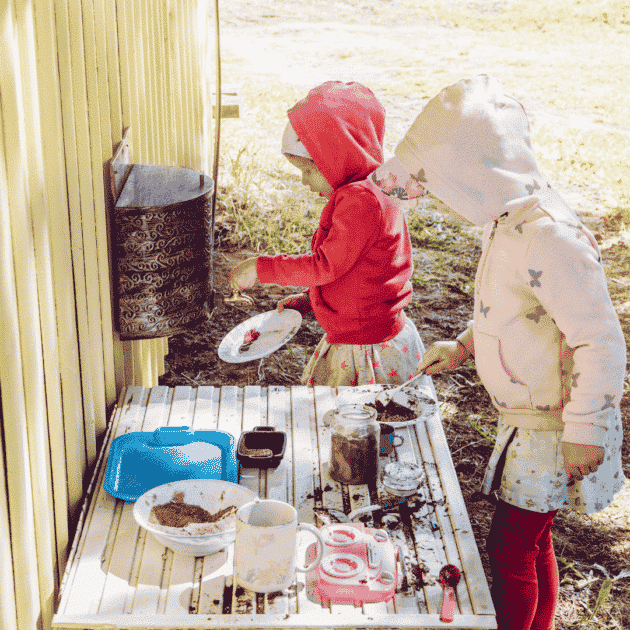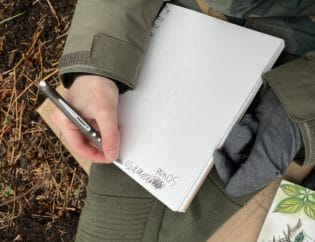
An imagination-sparking outdoor activity that keeps kids busy outside for hours is playing with a mud kitchen. Dirt chocolate lava cakes, mud cookies with leaf motifs, or pizzas with flowers instead of pepperoni…your mini chef will be serving up creative concoctions made from nature in no time. And you can be thrilled they are having fun outside.
What is a mud kitchen?
A mud kitchen can be any space outdoors where a child can pretend they are cooking and baking using mud and other natural loose parts. It can be as complex as a miniature model of a kitchen designed complete with cabinets, shelves, running water, and maybe even a window. Or it can be as simple as a clear spot outdoors with plenty of dirt and water around. You don’t have to get fancy. Most kids appreciate the open freedom to do things their way.

What are the benefits of mud kitchen play?
Let’s start with the obvious. Any activity that keeps a child busy outdoors in a safe and creative way is a keeper. The benefits of playing outside for a child’s developing mental and physical health are well known. In terms of outdoor activities for kids, playing in a mud kitchen is safe and, because it takes place in one spot, it’s easy for you to keep an eye on children as young as toddlers.
Mud play is a great way for a child to explore cause and effect on their own. There’s plenty of space for creativity to soar as they invent new recipes. And a great boost to developing fine motor skills (mixing, decorating, plating, etc).
And don’t forget that mud and dirt are good for kids. The germs are needed to build up immune systems. New research even suggests that certain microbes in soil have an antidepressant effect on us—making us happier!
Then there’s the fact that mud is an amazing sensory experience for kids as experiment with mud, water, and loose parts.
How can I set up a mud kitchen?
There are no rules for mud kitchens. Some key features include a surface to work on, a storage area for pots, pans, and tools, and possibly even a “sink” or a water source of some sort (a bottle filled with water works just fine).
Our best advice: work with what you have. Maybe you have an old desk you were looking for a good excuse to get rid of. Perhaps you have old cabinets or a small table hanging around. You don’t have to get fancy. You’re really just looking for a way to set up a surface for your child to use as a workspace. This can be accomplished with two tree stumps with a board placed across, just one tree stump, or just head outside and find a place kids can dig up dirt, place it in a bucket, add water, and presto! Dough!
To encourage your child to play in the kitchen, it’s ideal if the workstation is set at their height. Don’t make a taller child stoop down to play or a younger one stretch up. If they are comfortable, they are more likely to enjoy it.
If your child loves the activity, you can make or buy a more sophisticated kitchen. You can find many designs online on Amazon. You can even purchase blueprints on Etsy to make your own.
AOPARTS Kids Wooden Kitchen Play-Set available on Amazon
What supplies do I need?
Again, you can make this as simple or complicated as you want. If you have old kitchen utensils, here’s a great repurpose for them. You can also look for some at a thrift store.
Ideally, you can stock the mud kitchen with anything such as mixing spoons, cake tins, muffin trays, measuring cups. spatulas, forks, bowls. Small jars can be useful for collecting and storing loose parts such as acorns, flower petals, twigs, and seeds.

Sure this is supposed to be a messy kitchen but who doesn't like organization? You can keep the tools organized with hooks or shelves.
To prepare the mud, you will likely need a shovel, bucket, and water source. You can use a spigot outside or fill a watering can or water bottle with water.
You will likely find it quite useful to have an apron and damp towel or hand wipes around as a mud kitchen is one of the messiest of kitchens!
Go beyond mixing mud
Besides making wonderful recipes ala nature, your child can practice practical skills like counting and calculating by pretending they have a store. You can play the customer.

Safety precautions
Even though dirt is good for them, children should always wash their hands after playing in the mud, as there’s always a chance that animal feces might be in the mud.
Tip for making this less messy
Dress your child in clothing that you don’t mind getting dirty, boots, and an apron. Have a spare change of clothes ready by the door for when you return home.












